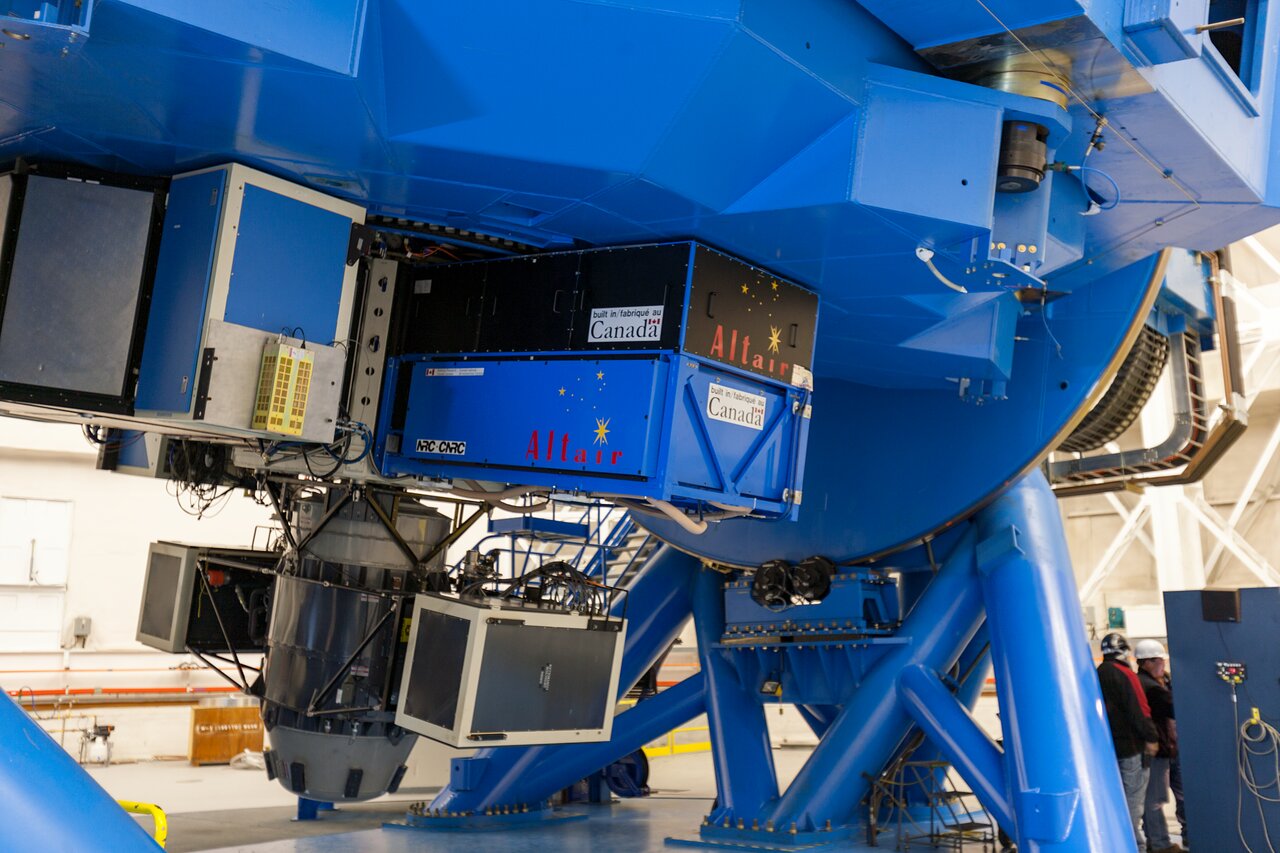Gemini Near-InfraRed Spectrograph (GNIRS)
GNIRS mounted on the back of the Gemini North telescope
The Gemini Near-InfraRed Spectrograph (GNIRS) at Gemini North, is a versatile instrument capable of detecting infrared light in wavelengths ranging from 0.8 to 5.4 micrometers. It has a variety of spectroscopic and limited imaging capabilities.
GNIRS offers four different spectroscopy modes. These include two slit-spectroscopy modes and two Integral Field Spectroscopy (IFS) modes. Slit spectroscopy can be obtained either with a long slit, targeting an individual wavelength region (X, J, H, K, most of L, or M) or of any portion of it, or alternatively in short-slit mode coupled with a cross dispersed prism, allowing for simultaneous coverage of the full 0.9–2.5 micron range. The low- and high-resolution IFS modes splits rectangular images into narrow strips and arranges them into full-length spectra while preserving the 2D spatial information. GNIRS also excels as an imager, though it has a relatively small field of view.
GNIRS can be used either with standard Gemini peripheral wavefront sensors, or with the ALTAIR adaptive optics module, which improves image quality by correcting for distortions caused by atmospheric turbulence. ALTAIR has both Natural Guide Star (NGS) and Laser Guide Star (LGS) capabilities.
GNIRS on the uplooking port of the Gemini North telescope with ALTAIR shown on one of the side ports
Science Highlights of GNIRS
- Dual Quasars Blaze Bright at the Center of Merging Galaxies
- Potential First Traces of the Universe’s Earliest Stars
- Precise Insights into the Supermassive Black Hole in the Milky Way’s Heart
- Blast from the Past
- A White Dwarf’s Surprise Planetary Companion
- Cosmic Tempest
Quick Facts
|
|
Gemini Near-Infrared Spectrograph (GNIRS) For scientists: Please find the most up-to-date details about the instrument offerings on the Gemini website. |
|
|
Site |
Maunakea |
|
Telescope |
Gemini North |
|
Type |
Spectrograph / Imager |
|
Wavelength range |
0.8−5.4 micrometers |
|
Pixel scale |
Depends on Camera Short Camera: 0.15 arcsec/pixel Long Camera: 0.05 arcsec/pixel |
|
Number of detectors |
4 |
|
Detector format |
1024 x 1022 pixels |
|
Detector total size |
1 Megapixel |
|
Spectral resolution |
Depends on mode, camera, and grating used. Slit Modes: 1200−18000 Low-Res IFS: 1700−7200 High-Res IFS: 1200−19000 |
|
Field of view |
Imaging: 0.1−0.35 arcmin2 (varies by filter/camera) Integral Field Spectroscopy (IFS): Low-Res IFS: 3.15 x 4.80 arcsec High-Res IFS: 1.25 x 1.80 arcsec |
|
Filters |
Y-MK, J-MK, K-MK, X, J, H, K, XD, H2, PAH, L, M |
|
Date of first light |
11 January, 2004 |
|
Science Goals |
Properties of high-redshift galaxies and active galactic nuclei Properties of high-redshift quasars Discovery of absorption systems at high redshift Monitoring of Solar System bodies Physical processes in supernova remnants Properties of low-mass brown dwarfs Properties of stellar winds in extremely massive stars Monitoring of periodically occurring novae Followup of dusty galaxy candidates Characterizing the environments of white dwarf stars |
|
Images taken with the instrument |
|
|
Images of the instrument |
|
|
Videos of the instrument |
|
|
Press releases with the instrument |
|

